-
Posts
76 -
Joined
-
Last visited
Content Type
Profiles
News and Information
Tutorials
Product Reviews
Supplier Listings
Articles
Guitar Of The Month
Links and Resources
Forums
Gallery
Downloads
Posts posted by avdekan
-
-
if the spruce ribs of the sound board are of high quality (they should dense, quarter sawn, straight grained and with no short grain), they are fantastic material for the bass bar and soul of violins, celli etc. they should be excellent material for classical guitar braces as well.
-
This is my 2nd project, which I finished last year and for some reason it took me until now to post here.
It was done as a birthday present for a good friend.
Since money was an issue I tried to keep the costs down, so the whole project cost me about 120$ and 20-25 work hours.
Design-wise I went for the labor friendly minimalist approach, and tried to make it as portable as I possibly could without sacrificing playability and comfort (I hope I managed to pull off that part). in short it's basically a wooden board with strings (which is what lap-steels generally are).
specs:
sapele block, maple "fret" markers and dots, danish oil finish.
brass bar bridge and bone nut.
economy tuners (I think they are made by Cort).
Kent Armstrong mini humbucker (I got it second hand).
single volume pot with push/pull for coil split.
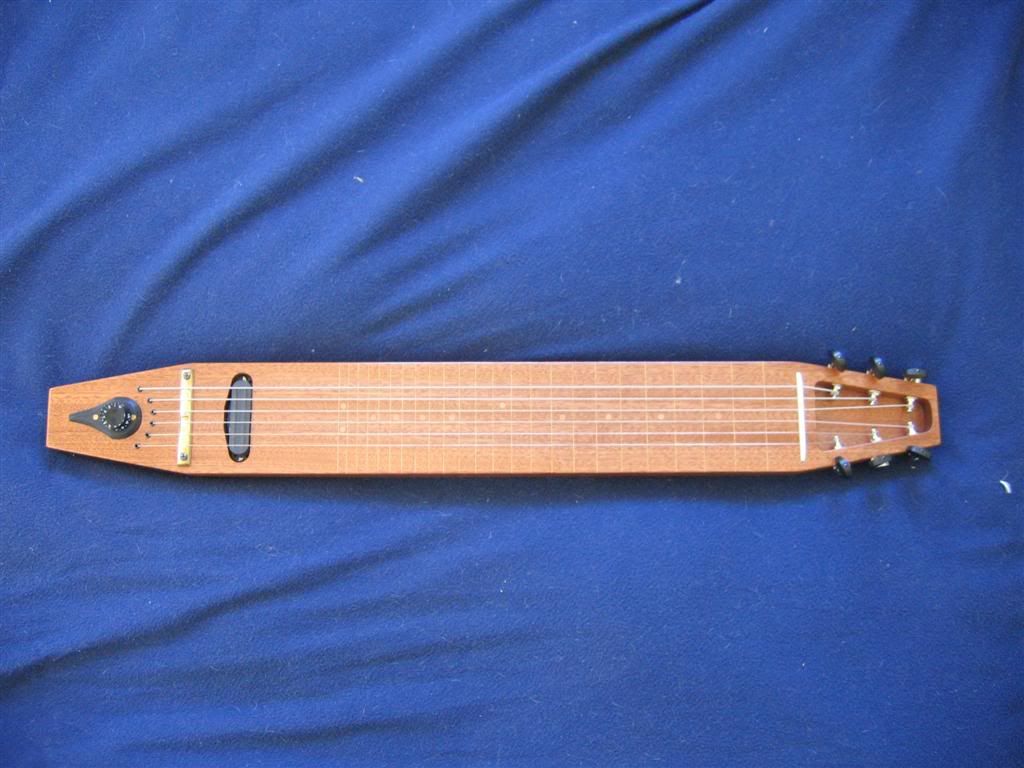
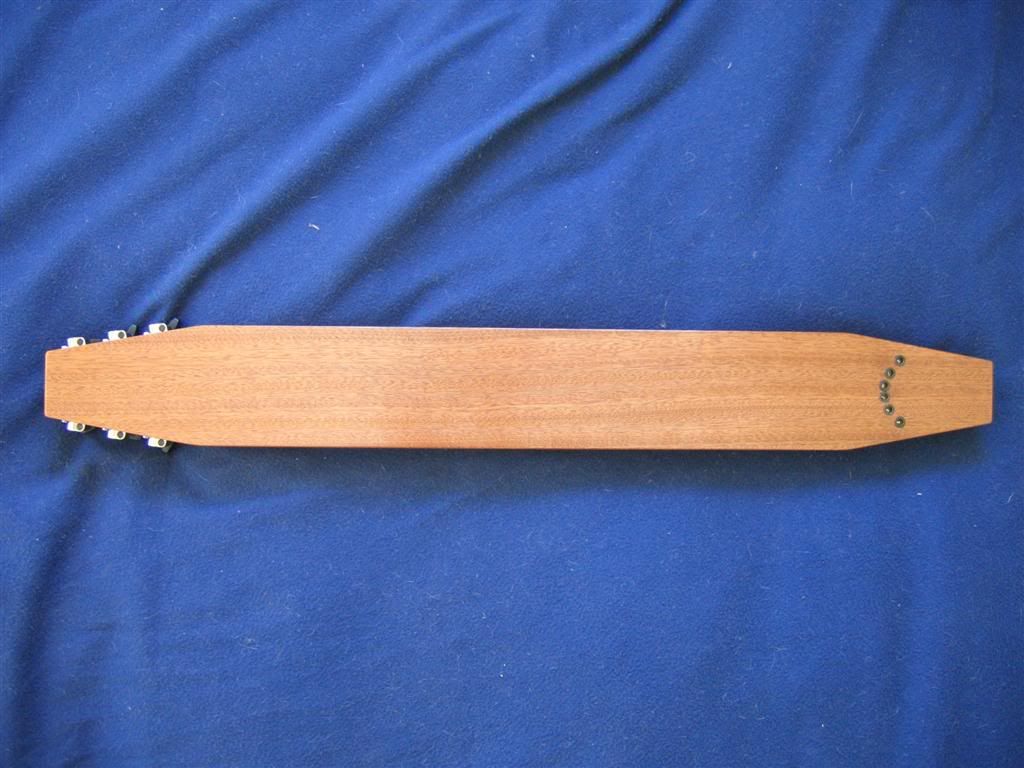

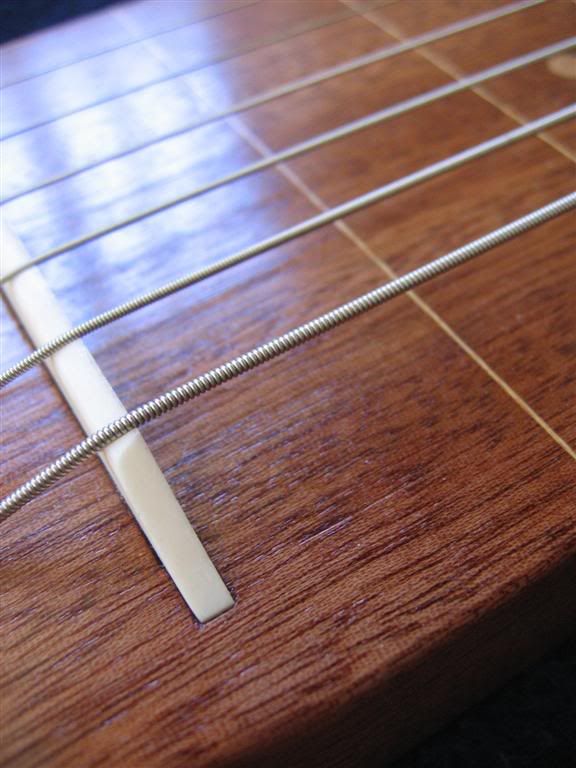
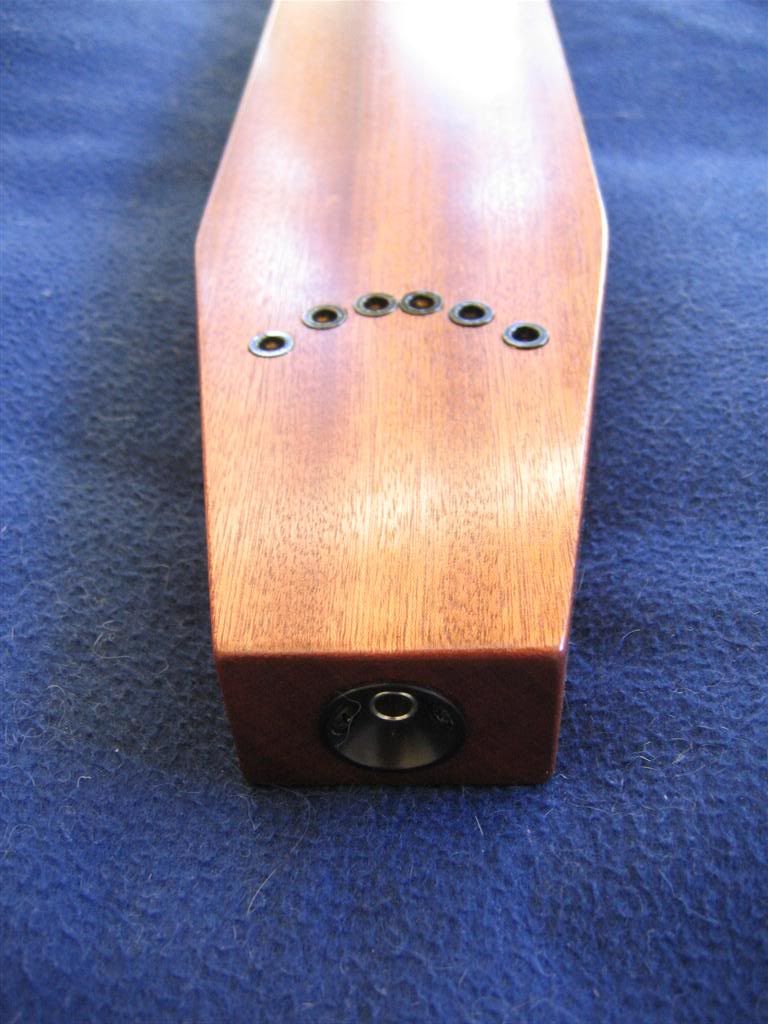
the lap steel sounds great and sustains forever. my friend is really happy with it. mission success!
B
-
Interesting guitar. You wouldn't know that it had been a strat.
Whats the pickguard made of?
Are those doggy slippers?
Pickguard is a piece of 2.5mm mahogany over 0.6mm maple veneer.
I since learned that a 2 piece lamination of woods this thin will warp, so now I do odd number of cross layers when doing wooden pickguards (3-5).
And yes, those are doggy slippers. every man should have a pair.
-
This was my first (half) project. did it about 4 years ago for a friend. the guitar used to be a samic strat but he needed a travel guitar so I chopped it...
the midi pickup is a later addition
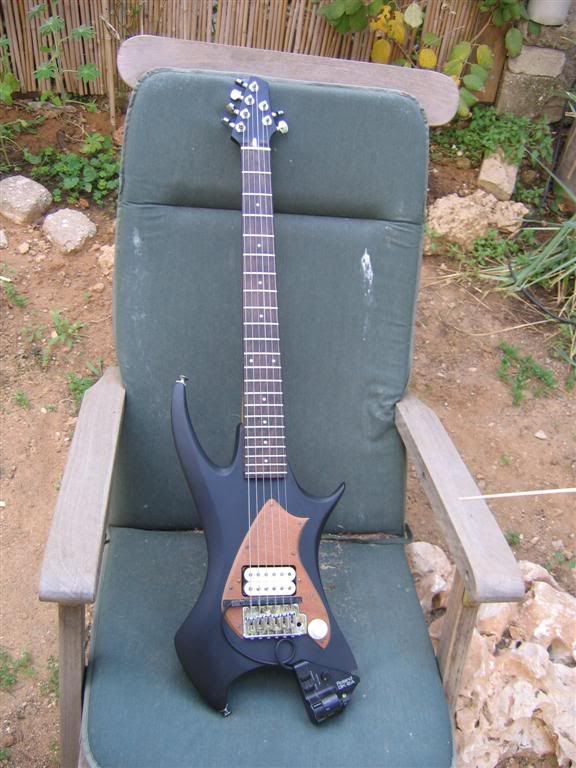
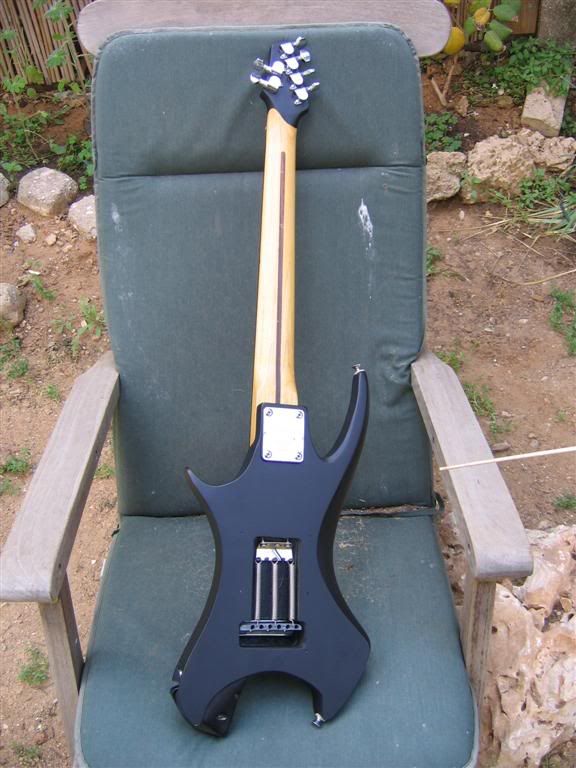
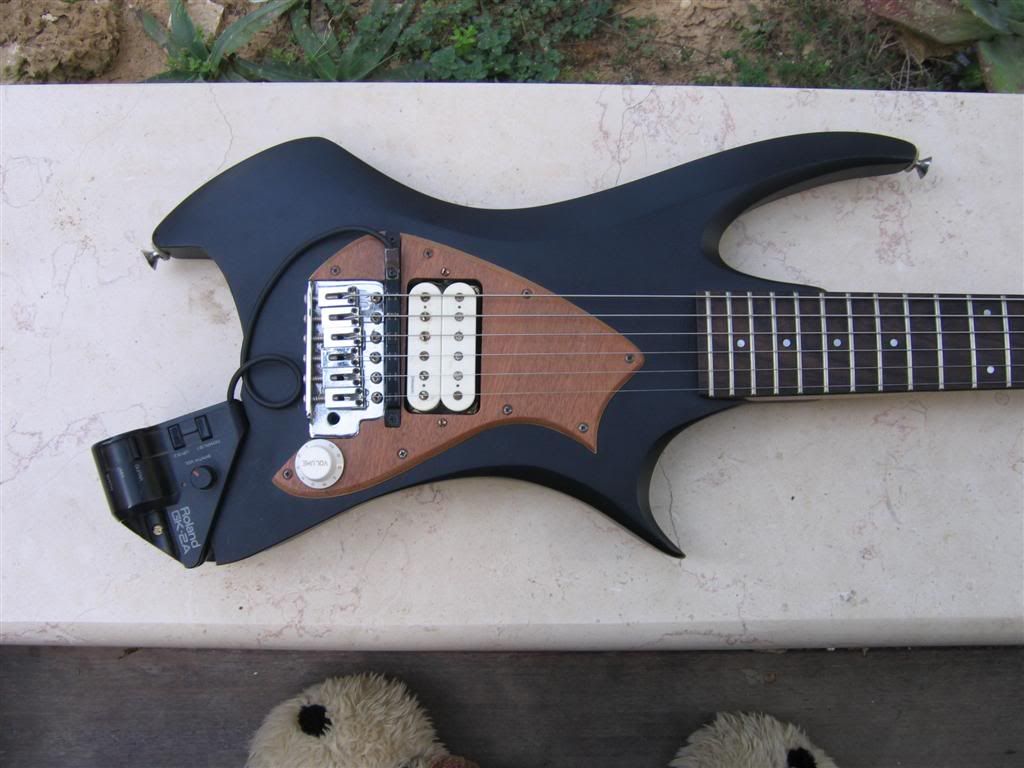
-
I built this (1st project) and the access is great. the lower horn doesn't extend much towards the neck so when you arch your palm over the fretboard to get to the high frets on the lower strings the horn doesn't get in the way.
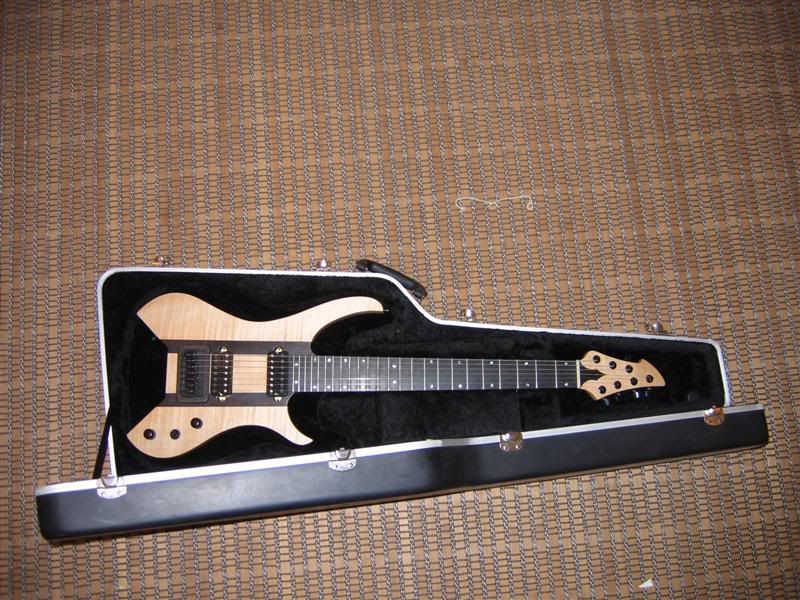

-
I would glue both halves of the top to each other, and after that glue the top to the body.
you should take care to prepare the gluing well. do it on a straight surface, and assuming you prepared the gluing surfaces so they are straight and match in angle (90 degrees), a light clamping force applied both downwards (to keep the top level) and towards the centerline should suffice.
another thing that I do is after the top is in one piece I clamp it to the body (or to any other straight surface) until I glue it to the body, so it doesn't warp.
and although it seems obvious to say, I'm gonna say it anyway: put nylon between the top and the bottom surface when gluing.
B
-
the 0000 steel wool that I have (don't remember by which company) equals to around 1500 grit paper, but I usually like going up to 2000 and then buff with a piece of cloth. If you can't find proper steel wool around where you live you can buy some wet sanding papers (no need for micromesh), 1200 - 2000 grit, and just go over the frets with them, then buff, and then apply oil.
B
-
I agree it looks like imbuya. If it is be careful it is a toxic wood.I'll second that guess. It does look like imbuya, except yours is a bit more lighter and yellow than the plank I have. (Might be due to the camera flash.)I've made some small gift boxes from it. It works easily and has a spicy cinnamon fragrance when sanded. That figure should make for an attractive top. Let us know how the bass turns out.
Wis.
MK
Imbuya it is then.
thanks,
B
-
It has been a while since I posted here (and since my last build), but now I'm building again
 .
.I am currently in the process of building a bass for a good friend of mine. we decided on a black limba body with a top that I'm unable to recognize (so I can't tell him what his bass is made of
 ).
). I got the piece of wood from which I made the top from the scrap wood area at a local hardwood warehouse (and there is enough wood for a second top)- it cost me close to nothing. the problem is that no one at the warehouse could tell me what it was. one guy said he thought it was Emboya, but he wasn't sure...
Anyway, here it is:
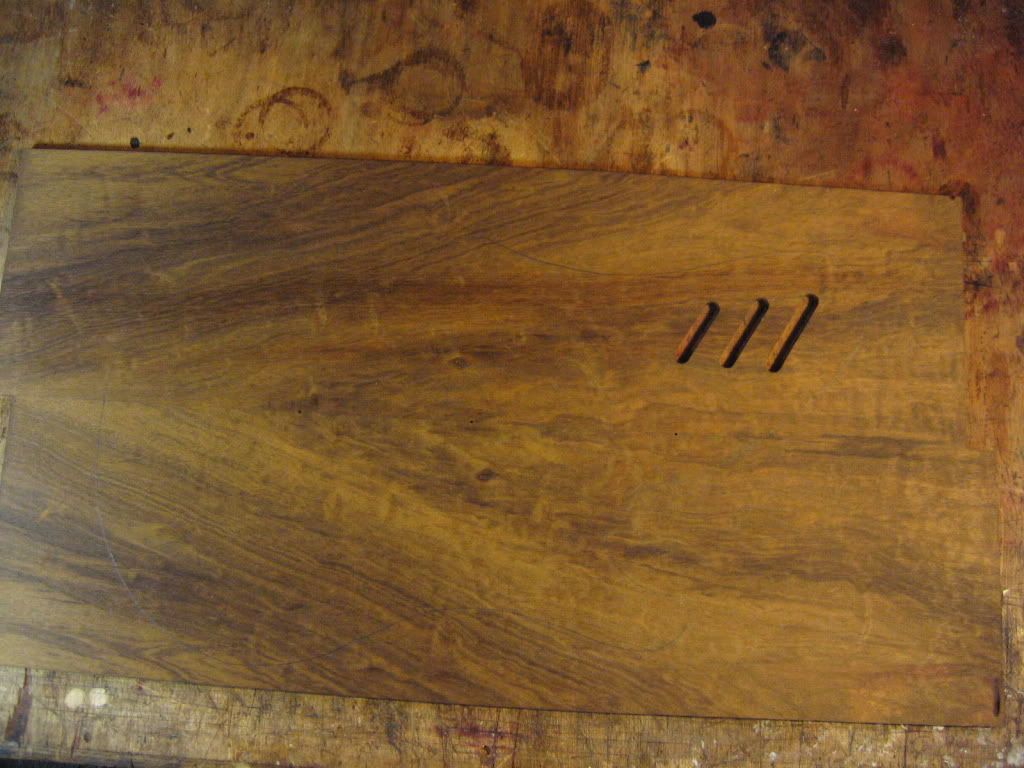
The lighting makes it a bit yello in the picture. in reality the color is greenish-brown (a bit darker then Lignum Vitae). It's a medium-weight wood and it produces a sort of a fruity smell when sanded.
Any input would be great.
thanks,
Binya
-
a friend of mine built an all black limba guitar (apart from the fretboard for which I don't remember what he used). it sounded fantastic. the only problem was that because this wood is not very strong the headstock seemed a bit fragile, so he added a headplate on the back of it (again, I don't remember which wood it was).
personally I love the looks and tone this wood gives.
WARNING: thread Hijacking follows:
Is white and black limba the same species?
-
to round the edge of the belly cut I use a scraper to scrape the length of the edge going gradually through various angles. after the edge is fairly rounded I use sandpaper with a soft part of the palm (the thumb for instance) to round it over.
-
Its possible, But you'll have to do a good job fitting the wood piece in there.
I think that simply taking a rectangle chunk out of the neck through end, going through the entire thickness of the bass is probably not such a good idea, since the two surfaces that go alongside the neck will probably be subjected to "crawling" due to string tension, and the remaining surface would be end-grain to end grain contact (weak).
I would suggest increasing the gluing surface with some sort of a "step" like a rabbet joint, or simply not to go all the way through in order to provide a gluing surface thats flat to the direction of the string pull.
Also, you will not have a bridge pickup since you are moving the bridge away from the pickups, and routing the piece of wood you are adding would severely weaken it.
hope it helps.
B
-
hi
I'm about to build a bass for a friend, and he wants it to have the Hipshot supertone bridge, which is a direct replacement for the gibson 3-point bridge.
Does anybody here have any idea what size are the studs (which are not supplied with the bridge)?
Are they the same as les paul TOM studs?
thanks.
-
thanks for the warm welcome.
this is not my first project. I've alraedy built a guitar, a lap steel, and another guitar is on the way.
I was thinking on probably using a hipshot fixed bridge and ultralite tuners to avoid the dreaded neck dive (wenge is HEAVY).
for the pups I was thinking either haeusse (precision and humbucking jazz set) or q-tuner, though I think the former will give me better resaults for my aim.
What would you say about using the swamp ash for the body, and "taking the edge off" with rosewood fingerboard?
-
Hi
I'm going to build a semi-hollow 4 string bass for a friend. opting for a vintage precision style sound but with a bit more "mojo", "spank" or whatever you want to call it.
the certain things till now are:
fretted!
tru-oil finish.
wenge neck, and a figured walnut top.
passive electronics.
still undecided, help needed:
I have two body blanks lying around to choose from: swamp ash and black limba.
I'm tempted to use the swamp ash but I'm afraid that combined with the wenge neck it will produce a midrange growl and brightness thats just too modern for such an instrument. will the semihollowness counterweight this? or should I just use the black limba?
for the fretboard I was thinking either ebony or ziricote, just to add a bit of clarity and highs, but I'm totally open to other suggestions.
what do you think will be the best sounding combination of woods?
thanks
-
thank you very much guys. will resort to traditional methods.
-
Search will bring you up a wealth of stories on Tru-oil from finished instruments to tutorials and discussions on application. I think it's wonderful stuff and can make otherwise normal or bland wood look pretty spanking gorgeous.
I tried searching but couldn't find anything about LMI's tru-oil sealer. I know that people use shellac and epoxy as grainfillers/sealers, or sand with the oil as lubricant to fill the pores. I just wondered what's that particular sealer all about?
-
No I mean that I have a prefered tuning, and seeing as i use that more than others, it would suggest that I should atleast try to achieve something for that sound surely?
you can have a set of resonating sympathetic strings with their own pickup that you can blend into the signal. that way you can change the scale/root notes they respond to. you could do just the one sympathetic string for the one note but I thing it would look kind of stupid on a guitar

-
I have a piece of bloodwood drying for over a year now and it doesn't seem to loose any color.
I know it's not a lot of time for wood but I take it as a good sign.
I'd like to hear a definite answer to that question too.
-
Hi
I was thinking of ordering tru-oil from LMI for a bass I'm going to build for a friend when I saw that they had a tru-oil sealer:
http://www.lmii.com/CartTwo/thirdproducts....ader=Oil+Finish
Is it just really thick tru-oil for the first layer or is there some hidden mojo in there?
what's your experience with it?
thanks
-
just a quick question as I'm trying to figure out the best way to level frets:
radius block with sandpaper, long straight beam with sandpaper or a grinding stone are the possibilities that come to mind.
what do you use? and why?
thanks
-
Compound radius is the way to go. If the fingerboard was the same width at both top and bottom, then it could be thought of as a cross section of a cylinder, but it's not. A fingerboard is a cross section of a cone which has different radius' at all points. Very small 'single radius' fingerboards are prone to fretting out, which means the string loses clearance when you bend it. Compound radius solves this problem, so the strings can be set lower without fretting out. It's quite difficult to build a jig to make a compound radius by machine, but luckily it's easy with a jack plane. If you align the edges of the plane with the center of the FB, you'll get a cylinder. If you align the edges of the plane with the sides of the FB, viola....er voila! A compound radius is achieved. This sounds hard, but in practice it's easy. Just use a fairly long body plane. Mine is 22", but I'm sure you could get exellent results with just a 12".
thanks for the reply.
about the hand plane method: I own a 18" plane (and some skill as well) and understand the logic behind your way of doing it, but I don't see myself achieving a consistent and "correct" radius across the width of the board quite so easily. got any tips for that?
-
hi
Two questions here:
My first question regards the "optimality" of compound radiusing the fretboard.
Now, I realize that compound radius is the phisically right way of doing it, but is the difference from the traditional way really that noticable to be worth the extra trouble (assuming that I want to be able to achieve the lowest possible action)? - Im talking about flat-ish radius here - 12" and above
the second question is what's the best way of doing a compound radius board?
will having a compound radius block machined and working it with sandpaper on the board (with small movement) be a good method, or should I go through the trouble of building something like this:
http://www.grizzlyindustrial.com/products/...ment-Only/G0577
and using is a-symmetrically to get the different radius at each end (I have a belt sander and a metal shop free access to build it).
Or should I just forget all about it and get one of stewmac's aluminum radius blocks?
I will welcome any thaughts/suggestions/advice with great thanks
Cheers, Binya
-
With the maple and wenge and the pickups, that must be one loud and bright guitar!
It is loud and fairly bright, but not in a painful way. can get very teleish when coil-split but gives a very punchy and articulate metal tone - which is my personal cup of tee.



Customised Brand Name Guitars
in In Progress and Finished Work
Posted
Hypnotic!!!